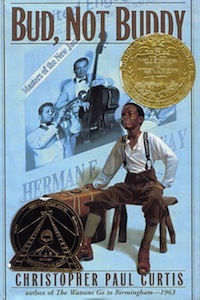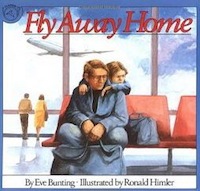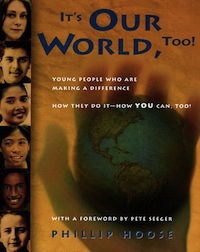Bud, Not Buddy

by Christopher Paul Curtis. ![]() Novel. 256 pages. Grades 4-8.
Novel. 256 pages. Grades 4-8.
Find this book: Amazon

Teacher's Guide

In this Newbery Award winning book we are asked to believe that a ten-year-old boy, without resources other than his own self-constructed list of rules "to Have a Funner Life and Make a Better Liar Out of Yourself", will find love, a home and a real family. Such is the skill of Christopher Paul Curtis that we take all that and more with hardly a nod toward the percentages.
Meet Bud, not Buddy, one of the most delightful young people you'll ever know. He belongs right in there with Maniac Magee (http://www.carolhurst.com/titles/maniacmagee.html) and others of their ilk who enlighten the human experience for readers and make us wish we could step into the action to help.
Bud's mother has been dead for four years when this novel opens and Bud is in an orphanage. He holds all the remnants of his once loving home in a cardboard suitcase: some flyers advertising Herman E. Calloway and various bands, a few mysteriously labeled rocks and his blanket. Soon he is farmed out to a foster home where he is abused. After pausing to wreak a funny, mild vengeance, Bud strikes out on his own, determined to walk from Flint, Michigan to Grand Rapids, the city listed in one of the flyers. Bud is convinced that his father must be Herman F. Calloway.
There are, of course, many set-backs on the way and many people who lend a hand. At the mission where Bud is too late for the evening meal, another homeless family pretends that he's with them. A very kind man who turns out to be a labor union organizer finds Bud hiding at the side of the road near a very intolerant village and takes Bud home to his own family before transporting him to his supposed father.
Having reached his destination, Bud's search must continue. He is still a child in search of family as it turns out that the musician cannot possibly be his father.
Bud's irrepressible good nature, his innocence and his survival skills make him memorable. His literal interpretation of language, his belief system which includes vampires, tokens and ritual behavior all serve to allow us to see the world through the eyes of a ten year old.
The setting in the 30s, the height of the Great Depression and the small tastes of racism that the author weaves in so skillfully make this book stand head and shoulders above the crowd.
(Continued Below)
Advertisement:

Things to Talk About and Notice
- There are certain things that Bud accepts as truth that you might differ with. For instance, he is sure that there are vampires and the only reason he accepts a ride from Mr. Lewis is that he is allowed to check his teeth and finds no fangs. What other beliefs does Bud have? Do those beliefs help or hurt him?
- If the setting of this book were in 2000 in your town, how would life for Bud be different?
- Why is Mr. Lewis so frightened to be outside a small Michigan town at 2 in the morning? What could have happened to him?

Activities
- Bud has a list of things to remember in order to survive. He calls his list, ""Rules and Things To Have a Funner Life and Make a Better Liar Out of You". Look at his rules and decide which of them proved to be helpful for Bud.
- Make your own list of rules for survival. Compare them to Bud.
- Make a map showing the action of this book from beginning to end.
- Compare Bud to Maniac Magee as far as background and personality are concerned.
- Compare this book with Nothing to Fear and Out of the Dust which are also set in the Great Depression. Think about the differences in the action of Bud, Not Buddy if Bud came from either New York City or the midwest, the setting of the other books.
- We learn a bit about the unionization of the railroad porters in Bud, Not Buddy. Make a list of the things you know from the reading and add to it things you find out by interviewing family members. Check those "facts" with research.
- Talk to a modern labor union organizer or union member to find out how they feel about unions.
 Check out some of the great picture book biographies of jazz artists such as
Check out some of the great picture book biographies of jazz artists such as Christensen, Bonnie. Django: World's Greatest Jazz Guitarist by Bonnie Christensen. (2009, Roaring Brook. ISBN 9781596434226. Order Info.
- The cardboard village of "Hooverville" is the scene of action in part of the book. Find out about such places in the 1930s. Did they all meet the same fate that this one did?
(Continued Below)
Advertisement:

Related Books

 Grades 1 - 5
Grades 1 - 5
Fly Away Home by Eve Bunting. Illustrated by Ronald Himler. Picture Book. 32 pages.
Find this book: Local Bookstore, Amazon, B&N
This is a sensitive book about a boy and his dad who live at the airport. Homelessness is not a common subject for any children's book and a picture book on this small family is a daring deed for Bunting and Himler to attempt. They had to walk a fine line to tell us this story. A misstep in any direction would have brought condescension, oversimplification, false cheerfulness or hopelessness and Fly Away Home is free of all those things. Read More in our Featured Book Teachers Guide with discussion questions, extension activities, related books and links.
 Grades 3 - 9
Grades 3 - 9
It's Our World Too: Young People Who Are Making a Difference: How They Do It--How You Can, Too! by Phillip Hoose. Nonfiction. 176 pages.
Find this book: Local Bookstore, Amazon, B&N
So much of the news of young people in our society is sad that it was fun to read It's Our World Too. I thought by the cover that these were all young adults but the chapter that moved me most was about a class of first and second graders in Sweden who bought a rain forest. The writing is personal, emotional and so skillful that the young people cited here seem real and not too good to be true. Their projects were/are worthwhile, possible to emulate, and inspiring. This is a book to hand to students and teachers who are reading about the environment, the homeless, the handicapped and the disenfranchised and are feeling overwhelmed and hopeless about any and all of these problems. Read More.- Miles to Go for Freedom: Segregation and Civil Rights in the Jim Crow Years by Linda Barrett Osborne. (2012, Abrams. ISBN 9781419700200. Order Info.) Nonfiction. 128 pages. Gr 6-12.
(Continued Below)
Advertisement:

Related Areas Within Carol Hurst's Children's Literature Web Site
- The Great Depression and Children's Books. Featured subject with books, activities and links.
- US History and Children's Literature. Book Reviews, classroom activities, related links.
http://www.carolhurst.com/subjects/ushistory/ushistory.html - Tolerance, Racism and Prejudice:
Featured Cross-Curriculum Subject with classroom discussion and activity ideas and some of our favorite novels, picture books and nonfiction for grades PreK-9.
http://www.carolhurst.com/products/booksetstol.html - The Watson's Go to Birmingham by Christopher Paul Curtis. Book Review.
http://www.carolhurst.com/titles/watsons.html - Maniac Magee by Jerry Spinelli. Featured Book with review, activities and links.
http://www.carolhurst.com/titles/maniacmagee.html - Out of the Dust by Karen Hesse. Featured Book with discussion, activities, related books and links.
http://www.carolhurst.com/titles/outofthedust.html - Martin Luther King Day, A collection of resources.
http://www.carolhurst.com/subjects/martinlutherking.html - Free Teacher's Guides: A listing of all our teacher's guides. Picture Books, Nonfiction and Fiction.

